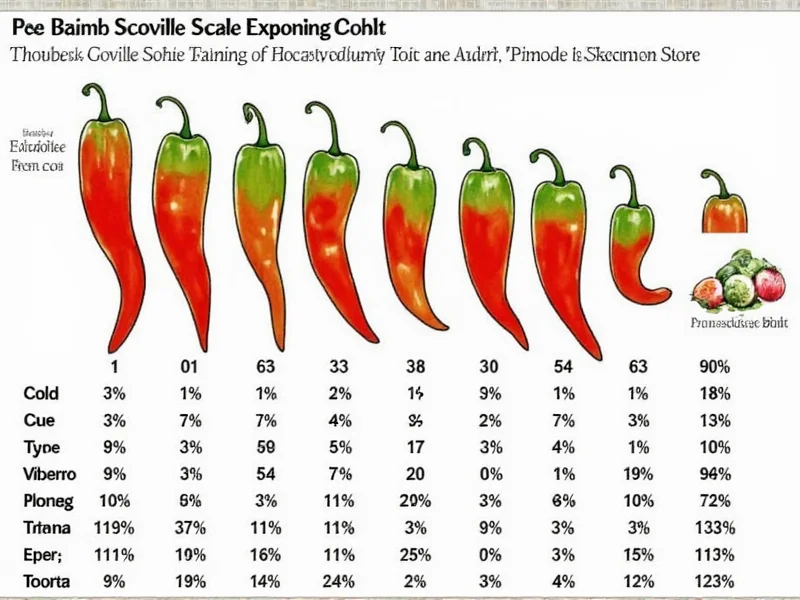Understanding the Scoville Scale: A Complete Reference Guide
The Scoville scale remains the definitive measurement system for chili pepper heat, developed in 1912 by pharmacist Wilbur Scoville. Originally relying on human taste testers diluting pepper extracts until heat became undetectable, modern laboratories now use high-performance liquid chromatography (HPLC) for precise capsaicin quantification, though results are still expressed in Scoville Heat Units (SHU) for public understanding.
Understanding pepper heat levels serves multiple practical purposes: selecting appropriate peppers for recipes, avoiding unexpectedly intense culinary experiences, and ensuring safety when handling extremely hot varieties. The scale spans five distinct heat categories, each with characteristic peppers that serve specific culinary functions.
Comprehensive Scoville Scale Pepper Chart
| Pepper Variety | Scoville Heat Units (SHU) | Heat Level | Common Culinary Uses |
|---|---|---|---|
| Bell Pepper | 0 SHU | Mild | Salads, stuffed peppers, stir-fries |
| Pepperoncini | 100-500 SHU | Mild | Greek salads, sandwiches, antipasti |
| Jalapeño | 2,500-8,000 SHU | Medium | Salsas, nachos, poppers, pickled |
| Serrano | 10,000-23,000 SHU | Hot | Pico de gallo, hot sauces, guacamole |
| Habanero | 100,000-350,000 SHU | Very Hot | Caribbean sauces, hot sauces, marinades |
| Ghost Pepper (Bhut Jolokia) | 800,000-1,041,427 SHU | Extremely Hot | Competitive eating, extreme hot sauces |
| Carolina Reaper | 1,400,000-2,200,000 SHU | Ultra Hot | Specialty hot sauces, chili challenges |
Practical Interpretation of Scoville Measurements
While the numerical values provide precise measurements, understanding what these numbers mean in practical terms proves essential for safe and enjoyable culinary experiences. The scale operates logarithmically, meaning each category represents a tenfold increase in capsaicin concentration. A habanero at 300,000 SHU contains approximately 30 times more capsaicin than a jalapeño at 10,000 SHU, not merely 290,000 units more.
Pepper heat varies significantly within varieties due to growing conditions, soil composition, and climate factors. A jalapeño grown in optimal conditions might register at the lower end of its range (2,500 SHU), while the same variety stressed by drought could reach 8,000 SHU. This natural variation explains why cooks sometimes encounter unexpectedly hot peppers even within familiar varieties.
Safety Considerations for Handling Hot Peppers
When working with peppers above 50,000 SHU, proper safety precautions become essential. Capsaicin oil transfers easily to skin and eyes, causing significant discomfort. Always wear food-safe gloves when handling hot peppers, especially those in the habanero range and above. Never touch your face while preparing hot peppers, and wash hands thoroughly with soap and water after handling—even after removing gloves.
For accidental exposure, dairy products like milk or yogurt provide immediate relief by binding to capsaicin molecules. Avoid using water, which spreads the oil rather than neutralizing it. In cases of extreme exposure from super-hot peppers like Carolina Reapers, seek medical attention if discomfort persists beyond 30 minutes.
Culinary Applications Across the Heat Spectrum
Chefs strategically select peppers based on both heat level and flavor profile. Mild peppers like poblanos contribute earthy notes without overwhelming heat, making them ideal for stuffed dishes and Mexican rajas. Medium-heat serranos provide bright, grassy flavors perfect for fresh salsas where heat enhances rather than dominates.
For authentic regional cuisines, matching traditional pepper varieties proves crucial. Thai cuisine relies on bird's eye chilies (50,000-100,000 SHU) for its characteristic heat, while Louisiana hot sauces traditionally use cayenne peppers (30,000-50,000 SHU). Understanding these regional preferences helps recreate authentic flavors while managing expected heat levels.
When substituting peppers in recipes, consider both heat level and flavor characteristics. A serrano can replace a jalapeño for increased heat, but a habanero substitution requires significant quantity reduction—approximately 1/8 teaspoon of habanero equals one whole jalapeño in heat intensity.
Measuring Pepper Heat: From Subjective Testing to Scientific Precision
Wilbur Scoville's original Organoleptic Test involved diluting pepper extract in sugar water until tasters could no longer detect heat. Five trained testers determined the final rating, with the dilution factor translating directly to SHU. While groundbreaking for its time, this method suffered from significant subjectivity and inconsistency between testers.
Modern laboratories use high-performance liquid chromatography (HPLC) to precisely measure capsaicinoid concentrations. The resulting data gets converted to Scoville units using a standardized formula (1 part per million capsaicin = 15 SHU), maintaining consistency with the historical scale while providing scientific accuracy. This method eliminates human subjectivity while preserving the familiar SHU measurement system consumers understand.
What is the Scoville scale used for?
The Scoville scale measures the heat intensity of chili peppers and other spicy foods by quantifying capsaicin concentration. It helps consumers understand and compare the spiciness levels of different peppers for culinary use, recipe development, and safety purposes.
How hot is a jalapeño on the Scoville scale?
Jalapeños typically range from 2,500 to 8,000 Scoville Heat Units (SHU). This places them in the medium heat category, making them versatile for many recipes where noticeable but manageable heat is desired. Actual heat can vary based on growing conditions and specific variety.
What's the hottest pepper on the Scoville scale?
The Carolina Reaper currently holds the Guinness World Record as the hottest pepper, with Scoville ratings between 1,400,000 and 2,200,000 SHU. It significantly surpasses previous record holders like the Trinidad Moruga Scorpion and Ghost Pepper in heat intensity.
How can I reduce the heat of a pepper in cooking?
Removing seeds and white membranes (placenta) significantly reduces heat, as these contain most capsaicin. Cooking peppers can mellow their heat slightly, and adding dairy products like yogurt or sour cream counteracts capsaicin's effects. When substituting, use smaller quantities of hotter peppers to achieve desired heat levels.
Is the Scoville scale measurement accurate for all peppers?
While the Scoville scale provides a standardized measurement, natural variation exists within pepper varieties due to growing conditions, soil, and climate. Modern HPLC testing offers precise capsaicin measurement, but published SHU ranges represent typical values rather than absolute constants for each pepper type.











 浙公网安备
33010002000092号
浙公网安备
33010002000092号 浙B2-20120091-4
浙B2-20120091-4